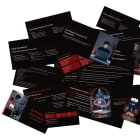AI-Assisted Product Development
Stop Asking Users What Features They Want (Do This Instead)
A brandable Workshop Kit is available for this article. Not yet a Coach-level Subscriber? Find out about the Workshops…
Hey there, 👋
Your product backlog has 147 items. Your CEO wants the dashboard redesign. Sales insists on SSO. Customer success is screaming for bulk actions. Engineering wants to rebuild the architecture. Your biggest customer just threatened to churn unless you build custom reporting.
Someone suggests “let’s ask ChatGPT what features we should prioritize.” You get back a reasonable-sounding list based on “industry best practices” that completely ignores your specific market position, technical constraints, and strategic goals.
Or worse, you build what the loudest voice demands, ship it in 3 months, and discover it doesn’t move your core metrics because you built what users requested instead of what they actually needed.
The result is feature bloat, strategic drift, and products that satisfy no one while trying to please everyone.
Most teams either build based on whoever yells loudest (HiPPO decision-making) or delegate product judgment entirely to AI, getting generic prioritization frameworks that work for someone’s context but not yours.
Why Traditional Product Development Fails
The Request Trap: Teams build what users request without understanding the underlying needs. Users ask for “better filtering” when they really need “faster way to find relevant items.” One request, multiple possible solutions with very different strategic implications.
The Loudest Voice Wins: Product decisions get made based on whoever has the most political capital, not evidence. The biggest customer’s feature request jumps the queue regardless of strategic fit or broader user value.
The AI Shortcut Delusion: Teams ask “ChatGPT, should we build feature X?” without providing context about their product strategy, market position, technical constraints, or success metrics. They get generic product advice that sounds smart but misses critical nuances.
The Mental Shift Required
From: “Users want feature X, should we build it?”
To: “Users requested X to solve problem Y. What’s the optimal solution to Y given our strategy and constraints?”
From: “ChatGPT, prioritize our backlog”
To: “Given our strategic goals, technical constraints, and user outcomes, help me systematically evaluate these options”
From: “Let’s build what customers ask for”
To: “Let’s understand what problems customers have, then decide the best solution”
The AI-Assisted Product Development Framework
Effective product decisions require four critical elements working together:
Need Analysis - Understanding the real user problem behind feature requests, not just building what’s asked for
Strategic Alignment - Evaluating features against product strategy and business goals, not just user demand
Build Decision Validation - Systematically determining build vs. buy vs. skip with evidence, not opinions
Launch Readiness - Defining success criteria and validation plans before committing resources
AI can systematically enhance each element when used with proper structure.
Quick Start Prompt
Use this when you need to quickly analyze any feature request or product decision:
I need to make a product decision about [FEATURE/REQUEST].
Context:
- Our product: [brief description, target users, key value proposition]
- User request: [what users are asking for]
- Who’s asking: [customer segment, how many users, revenue impact]
- Our constraints: [technical, timeline, resources]
Please help me analyze this systematically:
1. UNDERLYING NEED: What problem are users actually trying to solve? What job are they trying to get done? Strip away the solution they requested and identify the fundamental need.
2. ALTERNATIVE SOLUTIONS: Given the underlying need, what are 3-5 different ways we could address it? Include the requested feature plus alternatives they haven’t considered.
3. STRATEGIC ALIGNMENT: For each solution, how does it align with:
- Our product strategy and positioning
- Our target user segment priorities
- Our technical architecture direction
- Our business model and monetization
4. VALIDATION QUESTIONS: What questions must we answer before deciding? What assumptions are we making? What would we need to learn to be confident?
5. DECISION FRAMEWORK: What criteria should we use to choose between options? How should we weight different factors?
Focus on understanding the problem deeply before evaluating solutions.Sample Input: Feature = “Advanced filtering”, User request = “Sales team wants to filter by 15+ custom fields”, Who’s asking = “3 enterprise customers, $400K ARR”, Product = “B2B project management SaaS”
Quick Win: Use this before any product decision meeting. Spend 15 minutes analyzing with AI before spending hours debating opinions. Compare AI’s need analysis vs. what the team assumed.

